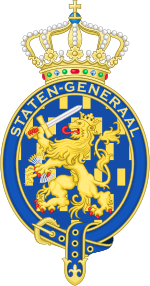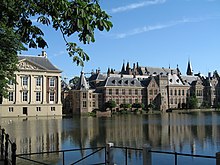

The States General in the Netherlands ( n. Staten-Generaal van het Koninkrijk der Nederlanden , also called Parliament , n. Het Parlement ) is the highest legislative body of the Netherlands.
Device
The States General consists of the First Chamber (also known as the Senate ) and the Second Chamber ( House of Representatives ). The Senate is elected by indirect elections by regional legislative bodies, the Second Chamber is formed by direct popular elections.
General States sit in the Binnenhof building (“Courtyard”) in The Hague . The First Chamber meets only one day a week and approves bills passed by the Second Chamber. Based on the composition of the Second Chamber, the government of the Netherlands is formed.
In the Knights' Hall ( Ridderzal ) of Binnenhof, solemn joint meetings of the chambers take place on the occasion of the opening of the session with the participation of the monarch (Princes Day, every year on the third Tuesday of September), in connection with the approval of the marriage of a member of the royal family or the death of the monarch. A joint meeting of the chambers has the right to also act as an authority in the event of a vacancy of the throne, the absence of an heir, and the regent’s inability to perform duties — in this case, he can elect a new monarch.
History
Initially, the highest estate-representative institution of the Netherlands provinces (which also included the territory of modern Belgium). General States consisted of members of the clergy, the nobility and the top citizens. They were first convened in 1463, after the unification of the Netherlands by the Burgundian dukes. The first meeting took place on January 9, 1464 in Bruges . The states-general had the right to vote taxes, and the “great privilege” of 1477 gave them especially broad powers. During the period of the Netherlands revolution of the XVI century, the States General became the center of opposition to the Spanish regime, and with the separation of the Northern Netherlands - the highest permanent legislative body of the Republic of the United Provinces . In the States General, each province had one vote, but part of the republic’s territory, the so-called General Lands , did not belong to the provinces, was governed directly from the center and did not have a vote in parliament.
General States existed until the Batavian Revolution of 1795 and were restored in 1815 in the United Kingdom of the Netherlands.
In honor of the States General was named Staten Island in New York (former Dutch colony New Amsterdam).